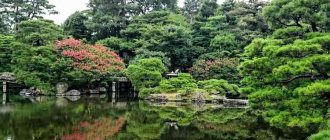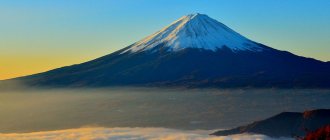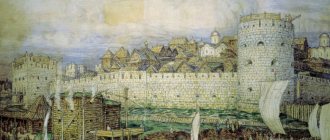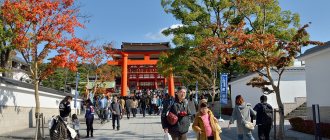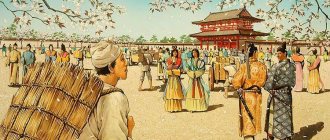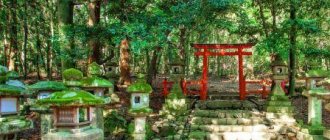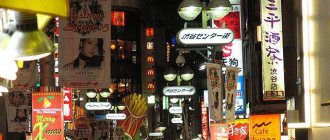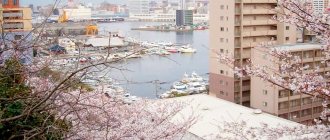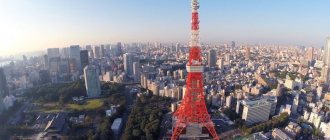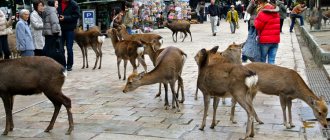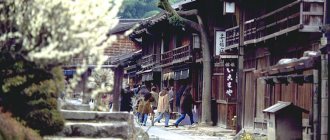Music creates a festive atmosphere
The sounds of gongs, flutes and drums echo through the evening Kyoto, and children's songs can be heard sung while selling timaki - rice balls wrapped in bamboo leaves. The eve of the Gion festival is called yoiyama, and the pre-holiday activities continue for three evenings, which are called yoiiyoiyama (July 14), yoiyama (July 15), yoiyama (July 16).
Gion-bayashi orchestra playing traditional music during the Gion festival
Shijo, one of Kyoto's main streets and home to large department stores, also changes dramatically during the holiday. There are many luxuriously decorated festive hoko and yama floats on display, including the Naginata-hoko, which reaches a height of 25 meters. Carts also stand on the streets that cross the city from north to south - Muromachi, Simmati. Nearby there are shops selling holiday goods - fans, tenugui towels, amulets.
Shimmachi Street is bustling with activity, with the Minami Kannon-yama cart (left) visible in the background. The shops sell tenugui towels, fans, amulets, each quarter has its own (right)
Evening falls and the paper lanterns that decorate the yama and hoko carts are lit. People dressed in traditional yukata clothing fill the streets of Shijo and Karasumaru, which become a pedestrian zone. At 10 pm, the Hiyori-kagura performance begins, when Hayashi musical groups from different neighborhoods march through the streets in orderly rows, and people in their hearts hope for clear weather on the day of the holiday. Tourists who have come to watch the festival wander around, listening to the overlapping sounds of different orchestras.
The musicians march towards the city center and will disperse to their respective neighborhoods after midnight
Features of the Gion quarter:
This elite old neighborhood is not at all a slum, overflowing with debauchery and vices. Art reigns here, not debauchery. In the o-taya, in the evenings, sophisticated intellectual conversations are held, classical national songs are sung, and ancient dances are performed. Those who are interested in red lanterns are in another quarter of Kyoto, Shimabara. There you will be served, robbed, and beaten, that is, you can get a full bouquet of thrills.
3.
A kind of geiko festival is held in April, when the cherry blossoms bloom. There are many performances there these days, tickets for which can cost $15-40, or approximately 1600-4500 yen.
During the day, geiko rest, and in the evening they put on ancient kimonos, do their specific pale makeup and go to work in o-chaya. At this time, tourists with cameras begin hunting for them, because during the day the geisha quarter is notable only for its ancient houses. But sitting in o-chaya and getting to know Japanese beauties better is not a cheap pleasure, a thousand dollars for two hours, and only on the recommendation of a regular at such places. Only very rich people go to such places in Japan. It turns out that you need to catch the exotic at 5-7 pm in order to take a photo of the artist going to work. Moreover, among these “photo hunters” there are no fewer Japanese than Europeans.
4. Gion Quarter in the evening
Only a Japanese can truly enjoy communicating with a geisha, and not everyone. After all, they are trained specifically to be a “perfect woman” in the Eastern sense, who amazes with the beauty of her dancing, singing, and ability to express her subtle and intelligent thoughts in conversation.
Now there are about a thousand geisha in Kyoto, and forty years ago there were 17 times more. They do not have such fabulous earnings, but work with very high demands. It is the Gion quarter in Kyoto that is the only place where this profession is taught in a special school. 15-year-old girls can only go there after a serious selection process.
5. Geisha near o-chai
A spectacular spectacle - the main procession of Gion
The morning of July 17th arrives. All the shops that stood everywhere have already been removed, and there is silence on the streets. The long-awaited time for the main procession of yama and hoko carts is approaching.
The Kita-Kannon-yama cart passes along Simmati Street. Participants in the festival in white haori clothes pull her by the ropes. Its height is more than 20 meters, and there are people sitting on the roof of the cart who make sure that it does not touch the wires
There are two types of carts - yama and hoko. The pit does not have a decorated roof; compositions of dolls are created on it. Hoko is a much larger cart with large wheels and a roof. Hayashi musicians sit under the roof and play festive music as the float moves in the procession. However, there are also pits that resemble hoko, like Kita-Kannon-yama, which has wheels and a roof.
Yama carts have puppet compositions, like the Kikkyo-yama cart (left). A man with a fan sits on a Hoka-hoko cart. His job is to set the pace of movement (in the center). The Fune-hoko cart is shaped like a ship (right)
Yamahoko procession on Shijo Street
A procession of thirty-three yama and hoko carts slowly moves through the city, with gion-bayashi bands setting the pace. Particularly noteworthy is the way the huge hoko negotiate turns. Their axles are stationary, so they place chopped bamboo under the wheels, on which the wheels slide, and thus turn the cart 90 degrees. The process is controlled by an ondotori, who shouts “yo-itose!” so that those pulling the cart apply force at the same time. Those watching this exciting spectacle held their breath... The turning of the carts at the crossroads, tsujimawashi, is one of the main spectacles of the holiday.
Kita-Kannon-yama cart commits tsudjimawashi
Maiko (apprentice geisha), dressed in yukata, also came to the celebration
The meaning of the holiday is to pacify the spirits of the dead
Gion Matsuri is considered Japan's most spectacular summer festival. Its history dates back to events 1100 years ago.
In Kyoto, which had long been the capital of Japan, infectious diseases often raged in the summer, claiming the lives of many people. The Kamo River, which flows through the city, is known for its restless nature, and with the onset of the summer rainy season, the tsuyu flooded every year, spreading throughout the city, and the stagnant dirty waters became the cause of epidemics.
It was not only the capital that suffered from natural disasters. In the sea in the Sanriku region in the northeast of the country in 869, a strong earthquake occurred, the so-called. "Earthquake of the Jokan Years." The magnitude was greater than 8.4, and it is believed that the scale of destruction caused by the tsunami generated by the earthquake was comparable to the Great East Japan Earthquake. There were also strong eruptions of the Fuji and Aso volcanoes... Such natural disasters, which followed one after another, were explained by people at that time as a curse from the spirits of people who died a violent death.
Angry onryo spirits had to be appeased throughout Japan. The Gion Festival originates from the “gatherings (to appease) the spirits” (goryoe) at the Gion Shrine (now Yasaka Shrine), which were held precisely in order to appease and calm the spirits.
Yoshida Kojiro, director of the Gion Matsuri Yamahoko Association, says: “A truly important role in the festival is played by the three mikoshi palanquins of the Yasaka Shrine. During the Shinkosai (Divine Visitation Festival) ceremony held on July 17, three deities, including Susanoo no Mikoto, are placed in sacred palanquins and taken to Otabisho (a place where carriages are left for a while). On July 24, Kankosai (Divine Return Festival) is held, when deities are returned from Otabisho to Yasaka Shrine. Through these two holidays, one cleanses oneself from filth and prays for deliverance from infectious diseases.”
The sacred mikoshi palanquin of the deity Susanoo no Mikoto leaves the Yasaka Shrine (left). The mayor of Kyoto makes a speech in front of three palanquins (right)
Initially, the yama and hoko procession was held before the Shinkosai holiday and after the Kankosai holiday, thus greeting and seeing off the deity, but now it is held only before Shinkosai.
Gion Geisha District and Yasaka Shrine
photo-shutterstock. by f11photo
Gion Geisha District and Yasaka Shrine in Kyoto, where the most famous festival in Japan, Gion Matsuri, is held in July - the Yasaka Shrine Festival, located just off the street next to Maruyama Park. Yasaka Shrine is the most famous temple in Kyoto, built 1350 years ago. This area has enjoyed a reputation as an entertainment district since the end of 1500. To this day, the best restaurants in Kyoto are located here, where you can dine with geishas, tea houses, and the Kabuki theater. The most famous tea house is Ichiriki Ochaya with traditional architecture and 300 years of history. The area is filled with restaurants of different cuisines, machiya (traditional houses in Kyoto), ochaya (teahouses) where geisha or maiko (apprentice geisha) entertain their guests.
The area was built to accommodate the needs of travelers and pilgrims visiting Yasaka Shrine. Eventually the area developed to the point where it became one of the most exclusive and famous geisha areas in all of Japan. The road along Sinbashi Road to the Sira River has been declared a National Historic District.
There are five hanamachi (places where geisha live) in Kyoto, called Kamishichiken, Bontocho, Miyagawacho, Gion Kobu and Gion Higashi. Each hanamachi is unique in its audience. For example, Kamishichiken is located close to the Nishizin area, most of the guests are from management. Bontocho is near the Nanza Kabuki Theater, so many actors visit it. Hanamachi Gion is the only community that is visited only by celebrities from politics, business and religion.
The most popular area of Gion is Hanami Koji Street, which runs from the Shijo area to Kenninji Temple. A good lunch spot, the street and its alleys are lined with surviving machiyas, many of which now function as restaurants serving kaiseki (Japanese fine dining) style food and other types of local and international cuisine. The Shijo area is a popular shopping area with shops offering local products including traditional sweets, pickles and artisan goods.
Guests can get acquainted with traditional arts by visiting Gion Koner, a traditional show that awaits tourists and takes place every day. This show is a very concentrated introduction to several traditional Japanese arts, and includes short performances of the tea ceremony, ikebana, bunraku, Kyogen theater games and dances performed by real maikos.
Another scenic part of the Gion district is the Shirakawa area, which is located along the Shirakawa Canal, parallel to Shijo Street. The canal is lined with willow trees, with upmarket restaurants and teahouses, many of which have rooms overlooking the canal. Since the Shirakawa area goes further inland, it is quiet and peaceful.
Ochaya (tea)
These are traditional establishments where in the old days, samurai were entertained by geisha for centuries. In the ochaya, or teahouses, there was a private and enclosed world where the evening's entertainment could include cocktails, conversation, and games, as well as listening to traditional Japanese music with dances and songs by sophisticated geishas. To this day, geisha and maiko can be found in the evenings when they go to the tea house.
For guests of the area, they offer lunch in the teahouse, where maiko or geisha, as experienced housewives, engage in light conversation, serve drinks, and perform traditional dances. Visitors see geishas usually when they are at work. Geisha know that they are a special and unique aspect of Japanese culture and a symbol of Japan. The goal of their work is to interest guests and discover part of their cultural life. But they want to be respected, which means that visitors must respect their work and if they want to take a photo, they must do so from the side or behind, without blocking their path.
There is a common misconception that Gion was a red light district. It was a geisha district, and since geisha are performers and not prostitutes, Gion was never a red light district. To date, the false impression has not been changed. The reason is that anything that happened here was not allowed to be known to the public. In fact, there was nothing that had to be strictly kept secret, people simply followed the traditional rule.
Maiko
A maiko is an apprentice geisha in western Japan, especially in Kyoto, Osaka and Nara. In the Kanto region, a girl in training is called a hangeku. Their future work consists of singing, dancing and playing the shamisen (a three-stringed Japanese instrument) for visitors during banquets. A maiko usually becomes a geisha between the ages of 15 and 20 after training, and it is also mandatory for a maiko to learn the Kyoto dialect, regardless of her origin.
Yasaka Shrine was founded more than 1,350 years ago. Yasaka Shrine is an important shrine for the people of Kyoto and is close to shopping areas. Some locals, speaking of it with respect, call it Gion-san Temple. People come here to perform wedding ceremonies, bless their newborn babies, pray for love, success or simply spend time in a beautiful place. And the presence of a large number of beautiful lanterns illuminating the dark time of the day makes it a great place for evening walks or a place to celebrate the New Year.
The temple also becomes popular during cherry blossom season in early April, as the adjacent Maruyama Park is one of the most famous cherry blossom viewing spots in Kyoto. Yasaka Shrine is dedicated to the gods Susano, Kishiinadahime and Yahashira - these are great gods in Japanese mythology, famous for their battles with Yamata no ori (a large snake with eight heads: a symbol of many disasters).
The shrine's main hall combines the honden (inner sanctum) and haiden (adjacent hall) into a single building. In front of it is a platform with hundreds of lanterns that illuminate the building in the evenings. Each lantern is named after a local business that has donated to the temple. The stone gate on the south side is 9.5 m high - one of the largest in Japan and dates back to 1646. The two wooden statues, the koma inu (lion dog) guards of the temple, are said to have been carved by the famous sculptor Ankei, who created many of the statues goddess Kannon at Sanjusangendo Temple in the 13th century.
Initial construction of the temple began in 656. The temple was under the patronage of the Imperial Court during the early Heian period. In 965, Emperor Murakami ordered that the site be designated a shrine; and in 991, Emperor Ichijo added three more shrines to Murakami's list. Three years later in 994, Ichijo improved the scope of this list by adding the Umenomiya Shrine and the Gion Shrine. Most of the buildings we see today date back to 1654.
From 1871 to 1946, Yasaka Shrine was officially designated as one of the Kampei temples, meaning it was in the first rank of government-supported shrines.
Seven mysterious legends about Yasaka Shrine:
- Nishiromon (Nishiro Gate)
Nishiromon is the representative gate of Yasaka Shrine. Nishiromon are identified as an important cultural heritage of Japan. It is said that Nishiromon never grows cobwebs and even when it rains, there is no sign of rain on the gate.
- Ryuketsu (Dragon)
They say that a dragon lives here, which lurks deep, well below the main hall, and can lead to underwater palaces.
- Dragon's Roar
When you clap your hands, the clap will echo in the pillar facing the west side. They say it is the roar of a dragon that responds to sound.
- Tadamori toro (traditional lantern made of stone)
On a rainy night during the Keikyu period (1113-1118), Emperor Shirakawa saw a ghost on his way to Gion, and he said that a monk would kill him. Fearing the prediction, the Emperor ordered his courtier Tadamori to kill the old monk, but he disobeyed the order because he met him with fire, which he was carrying to the people. People admired Tadamori and his just action, and the lantern was a tribute to the old monk.
- Futami Rock
The rock between Daijingu and Yasaka temples is called Futami Rock. The rock of the root is said to be very deep, reaching to the core of the earth.
- Biyosui (beauty water)
The temple is dedicated to three Goddesses called Ichikishimahime, Tagirihime and Tagitsuhime. They are the daughters of Amaterasu (goddess of the sun) and Susano (god of the sea and storms) - Japanese gods. Ichikishimahime is considered the most beautiful, known as the goddess of beauty, talent and wealth. The god of beauty is worshiped in the sub-temple. It is popular among geisha, maiko and women who want to stay young and beautiful for a long time. In spring many women come to the temple. They say that if you wash your face here in the spring, it will become even younger and more beautiful, this place is called Biyosui (beauty water).
- Yonaki ishi (stone that screams at night)
In front of the Hiyoshisha sub-temple, in the Yasaka Shrine, there is a large tree. Next to the tree is a stone called Yonaki Ishi. They say that the stone screams at night.
Yasaka Shrine is famous for its summer festival, Gion Matsuri (Gion Festival), which is celebrated every July. Perhaps the most famous festival in the country, Gion Matsuri dates back more than a thousand years, and the parade with hundreds of participants is amazing in size. In 869, omikoshi (sacred palanquins) were taken from the temple and carried through the streets of Kyoto to ward off an epidemic that struck the city. This was the beginning of the Gion Matsuri festival. Today it is an annual festival that has become world famous.
In close proximity is the Pontoche district, one of Kyoto's traditional nightlife districts, where you can meet a maiko apprentice geisha.
How to get to the Gion area and Yasaka Shrine: From Kyoto Station, take bus No. 100 and 206 (20 min, 220 yen) to Gion stop or take a 20-minute walk from Kyoimiduzudera Shrine through the Higashiyama Historic District.
Sights of Japan, excursions in Japan, group and individual tours in Japan from the Japanese company AFCOM (VOYAGEJAPAN) voyagejapan.com
Yama and hoko are the pride of the people of Kyoto
The yama and hoko procession used to play a secondary role, but the people of Kyoto brought it to the center of the festival. When Kyoto once again became the center of political power in the country during the Muromachi period (1336-1573), merchants and industrialists, sake sellers and pawn shop owners (in the current sense
– financiers) were gaining strength. Parishioners began to bring carts from their neighborhoods into the procession. During the turmoil of the Onin years (1467-1477), which broke out due to a dispute over the succession to the title of shogun of the ruling house of Ashikaga, Kyoto turned into a scorched plain, and the Gion festival was not held for some time, but the inhabitants of those quarters revived it, and since then Gion has truly become a holiday for the townspeople.
During the Azuchi-Momoyama (1573-1603) and Edo (1603-1868) periods, with the development of overseas trade, yama and hoko carts became even more luxurious.
Ishikawa Taku, chairman of the Kita Kannon-yama Preservation Society, also says that at one time residents competed to see which neighborhood had the most beautiful cart, and competed in the luxury of decorations.
He says: “The merchants of Kyoto, as a rule, were thrifty people and led modest lives, but they gave willingly on holidays. In our Rokkaku quarter lived rich merchants - Mitsui, Matsuzakaya, they invested money in decorating carts, ordering fabrics from afar - from Tibet and Persia. The handicraft jewelry is also extremely luxurious. People of that time could rarely see something like this. This showed local hospitality - inviting people who helped organize the Gion Matsuri and sharing the joy with them.”
The carts are richly decorated
Due to the fact that wealthy residents competed to see who could give more money to decorate the carts, valuable decorations from all over the world were collected for them, and therefore they are called “museums on wheels.” Luxuriously decorated carts are also a source of pride for the people of Kyoto. Gradually, more and more people gathered for the holiday in order to at least once look at these wonderful carts.
Gion Matsuri served as the prototype for many summer festivals held throughout the city. There are many of them throughout the country, such as the Hakata-Gion Yamakasa holidays in Fukuoka, the Takayama Matsuri in Takayama Prefecture. Gifu, Mikumayama Matsuri in Takayama Prefecture. Toyama and many others.
Kyoto's hospitality is shown during the holiday
The hospitality of the people of Kyoto is also evident in the Byobu Matsuri festival. During the pre-Yoyama holiday period, residents of the neighborhoods participating in the holiday took out folding painted byobu screens and other works of art, carefully stored in the pantry, to show to relatives and friends. Now such items are already on display for all tourists who come to see the Gion Matsuri.
In Kita Kannon Yama there is also a house where byobu screens are displayed (left). Tourists admire the works on display at the Byobu Matsuri (right)
Ishikawa Taku says that Yoiyama is a special time for everyone living in Kyoto. To please guests, things that are usually impossible to see are put on display for inspection.
Some features of Kyoto cannot be experienced without attending the Gion festival, which demonstrates the spirit of hospitality of the local residents.
Photos: Nakano Haruo
(Article in Japanese published September 13, 2013)
Other interesting places in Kyoto
Nijo Castle
Palaces and castles
- Nijo Castle was once a powerful shogun (military dictator) of Japan.
- The Imperial Palace in Kyoto, where the imperial family lived until 1868.
- Villa Shugakuin was built by the retired Emperor Gomitsuno (1656) in the suburbs of Kyoto.
- Villa Katsura was also an imperial residence and has several beautiful Japanese gardens.
Public places
- Surrounding the beautiful Kiyomizudera Temple is the Higashiyama Historic District.
- Arashiyama is a beautiful tourist area on the outskirts of Kyoto.
- Of course, you can shop in Kyoto on Shijo-Dori Street.
Temples
How do you like this, Elon Musk? Japanese monks will build a new temple... in space!
- Kiyomizudera, which is almost entirely made of wood, especially the giant terrace, is very impressive.
- Sanjusangendo has no less than 1001 statues in realistic format.
- Nanzenji Temple is entirely dedicated to the establishment of Zen, surrounded by a beautiful rock garden.
- Ninnaji Temple was once the home of an imperial couple.
- For a beautiful stone garden, you can go to Ryoanji Temple.
- Byodion Temple is famous for its beautiful garden around it.
- In autumn, you can go straight to Tofukuji Temple because the forests around it have beautiful autumn colors.
Parks and Japanese gardens
Kokedera or Saihoji Temple, Kyoto
Kokedera, also known as Saihoji, is probably one of the most beautiful Japanese gardens in the world . Kokedera means "temple of moss", it received this name because moss grows everywhere.
Views: 2,280
Share link:
- Tweet
- Share posts on Tumblr
- Telegram
- More
- by email
- Seal
Liked this:
Like
